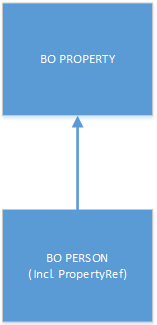Field as super/sub
• When exporting business objects you can determine the hierarchical structure in the XML output by specifying the Field as super or Field as sub.
• When importing hierarchical business objects, you must define the structure correctly in the Field as super or Field as sub definition.
Example
This example outlines how to export a person and the property to which this person is assigned.

If the exported XML should look as follows:
<businessobjects>
<Person>
<Code>127</Code>
<LastName>Alkin</LastName>
<FirstName>Matt</FirstName>
<Property>
<Code>14</Code>
<Name>Columbus Square</Name>
<City>London</City>
</Property>
</Person>
</businessobjects>
<Person>
<Code>127</Code>
<LastName>Alkin</LastName>
<FirstName>Matt</FirstName>
<Property>
<Code>14</Code>
<Name>Columbus Square</Name>
<City>London</City>
</Property>
</Person>
</businessobjects>
• Then in Enterprise Talk go to the business object that contains the reference field: BO Person.
• Define the PropertyRef field as a Sub, because in the XML hierarchy, the property is at a lower level than the person (property is nested inside BO Person).
If the exported XML should look as follows:
<businessobjects>
<Property>
<Code>14</Code>
<Name>Columbus Square</Name>
<City>London</City>
<Person>
<Code>127</Code>
<LastName>Alkin</LastName>
<FirstName>Matt</FirstName>
</Person>
</Property>
</businessobjects>
<Property>
<Code>14</Code>
<Name>Columbus Square</Name>
<City>London</City>
<Person>
<Code>127</Code>
<LastName>Alkin</LastName>
<FirstName>Matt</FirstName>
</Person>
</Property>
</businessobjects>
• Then in Enterprise Talk go to the business object that contains the reference field: BO Person.
• Define the PropertyRef field as a Super, because in the XML hierarchy, the property is at a higher level than the person (person is nested inside BO Property).
The same principle applies to importing a business object. |